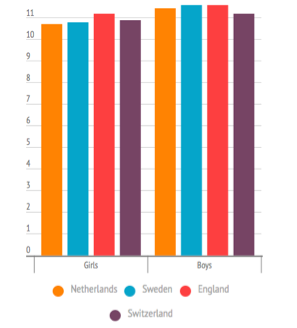GRSJ 224: The Early Sexualization of Young Girls
The Early Sexualization of Young Girls
Young girls' early sexualization designates the phenomenon of girls' manifestation of sexual behaviors at an early age. This phenomenon also named hypersexualization, or precocious sexualization, is defined as the treatment and the depiction of girls as sexual objects as well as their interest to appear as sexualized being. The phenomenon of girls’ early sexualization also encapsulates their desire to enter into an adult world by adopting a sexualized appearance and attitude. It appears that, because girls are exposed at an early age to sexual content, they develop a sense of oneself as a sexual being before their teenage hood.
Also, young girls' early sexualization is a phenomenon that mostly concerns occidental societies.
Definition
Sexualization takes place when one's value comes primarily from her or his sexual appeal or behavior to the exclusion of other characteristics, and when one is mainly depicted as a sexual object. While sexualization is considered as normal during the late teenagehood (16-17 years old), it is however perceived as detrimental during childhood and pre-teenagehood.
Today, it appears that sexualization is imposed on girls at a premature age, thus, when they are not yet psychologically mature to understand what being sexualized implies. Thus, girls are drawn into an adult world that, because of their young age, they are not ready to face. Indeed, adult sexual concepts are seeping into girl world at a time where they are not developed mentally and cognitively equip to comprehend the conveyed messages. In fact, young girls are exposed and have to deal with an uncountable number of sexual connotations. Unfortunately, their exposure to these sexual connotations occurs at a vulnerable period in their lives: where they are in search of role models and open to a sense of discovery. Therefore, girls are expected to act like mini-adults which narrow the separation between the adult and children' s world.
Evolution
Today, girls are encouraged to have sexy looks and to have sexualized beliefs while they, in fact, don’t know much about the signification of being sexual, having sexual desire, and making reasonable decisions about pleasure and risk within intimate relationships that acknowledge their own desires. However, this hasn't always been the case. Indeed, Early sexualization is a recent phenomenon that arose during the 1990’s.
With societies' evolution, young girls' sexualization has been, and is still, increasing as well as occurring at an earlier age. Indeed, up to 15 years ago, behaviors that were viewed as not typical for girls and that would have alarmed anyone, are today more common. Nowadays, young girls are dieting, wearing makeup and even receiving esthetic care A survey led by the NPD Group [1] demonstrates that, on average, 43 percent of 6- to 9-year-olds are already using lipstick or lip-gloss; 38 percent use hairstyling products; and 12 percent use other cosmetics. The same study reveals that four years ago women began using beauty products at 17 while today, the average age is 13 years old.
Furthermore, according to an article in the Huffington post[2], Girls between the age of 8 years of and 12 years old spend, in average 40 million a month on beauty products. Also, this article substantiates that girls as young as six years old are wishing to look like the dolls who have sexy outfits, and not to the ones dress up stylishly, but covered up. It actually appears that these young girls associate the idea of being sexy and wearing sexy clothes with the one of being popular.
The opinion of young girls of their body [3]and the preoccupation their weights also derive from the early sexualization phenomenon. A study led by the dove Real Beauty campaign in 2004 showed that in the United Sates, 42% of first- to third-grade girls want to be thinner while 81% of 10-year-olds are afraid of getting fat
Causes
Media
The amount of time young girls spend consuming media every day keeps increasing year by year. Girls between 8 and 18 years old allocate 6 and a half hours of their day to media[4]. The time girls consecrate to media each day is actually tied to the early sexualization phenomenon because sexuality is inappropriately imposed upon them during this time. In the majority of mainstream media, we can find evidence of strong objectification of girls. Indeed, women and girls are depicted in a sexual manner in movies, television shows, music videos, the Internet, video games, and advertisements. It is very common to see magazines, ads, television programs, movies that target a young audience and that feature women dressed up in a sexualized manner, if not undressed. The main issue here comes from the fact that girls develop their self-concept, mentality and personality by imitating the way in which women are represented in the media (Huston & Wright, 1998). Moreover, the Kaiser Family Foundation discovered that young girls consider today's media as their primary source for information on sexuality and sexual health. Unfortunately, they are not aware of the fact these media representations of sexuality are unrealistic.
Television
Girls spend a considerable amount of their time in front of TV shows that address a young audience. Indeed, TV shows such as Gossip girls, Pretty little liars, The vampire diary and an uncountable of other in the same genre, feature underage characters that have sexualized behavior, appearance, and that are often involved in sexual encounters before the end of high school. Therefore, in these TV shows, there is a proliferation of sexualized images of girls and young women that are harmful to them. Thus, young girls are ceaselessly exposed to TV images that entail a sexual content and girls incorporate these images to such an extent that they perceive those as the norm.
Magazines
Magazines also have their part to play in the phenomenon of young girls early sexualization. Today a high number of magazines that are addressed to teen girls, such as Girls' life, Teen vogue or even Tween girl style magazine provide makeup advice, "sexy hairstyles" diets, and exercises program to lose weight.
In a 2010 UK study, one third of 14 to 16 year olds reported they had first seen sexual images online when they were 10 or younger.[1]
More alarmingly is the issue of the increasing early sexualization or hypersexualization of young girls in fashion magazines. The hypersexualization of young women and girls have become an increasing topic of controversy in our current society. The American Psychological Association defines hypersexualization as “occurring when a person’s value comes only from his or her sexual appeal or behavior to the exclusion of other characteristics.”[2] Hypersexualization of young women or even premature girls is seen as girls being depicted or treated as sexual objects, which is becoming increasing prevalent in the media. Hypersexualization of young women and girls is also known as sexualization, early sexualization, or precocious sexualization. It also means sexuality that is inappropriately imposed on girls through media, marketing or products directed at them that encourages them to act in adult sexual ways.[3] A research from 2008 in Wesleyan University of 1,988 advertisements from 50 well-known American magazines found that half of them show women as sex objects. Although the amount of sexual content in American magazines are increasing, the age of women as objects of the sexual content is decreasing.[4]
In 2011, the well-known magazine, French Vogue, caused a controversy when Thylane Blondeau, a 10-year-old child model was featured in a shocking provocative pictorial. The15-page spread in the French Vogue issue guest-edited by fashion designer Tom Ford evoked international concerns from parents, child abuse advocates, and developmental psychologists as well as the general public. The images were criticized for being hypersexalized due to the child model looking like a seductive woman.[5]
The French child model Thylane Blondeau’s entry to the fashion industry follows a recent trend for younger models. Hollywood child actresses Elle Fanning, 13 years old, signed a modeling deal with Marc Jacobs, and 14-year-old Hailee Steinfeld recently signed modelling deals with Miu Miu. Criticisms towards fashion magazines and the fashion industry are arising rapidly as children are exposed to “to a world she is not yet equipped to deal with solely to serve the needs of the adults around her.”[6]
Internet
The Internet is part of the problem of early sexualization as well. Through The Internet, girls have to constantly deal with advertisings that picture women in suggestive poses or wear sexy outfits. Since teens' use of Internet as been severely increasing over the past ten years, they are more subject to these images Moreover, Internet has enabled the development of social media such as Facebook or Instagram. Young girls have a total freedom within those social media, which means that they can encounter contents such as pictures or videos that they are not mentally and psychologically ready to understand. Furthermore, with the rise of Internet, the access to pornography is today easier than it was in the past. As a matter of fact, pornography has been introduced and has unfortunately ensured its place in today’s popular culture. The RQASF[5] blog states that the pornography industry imposes its culture on advertising and media as well as on the manufacturing industry for teens. The RQASF[6] argues that the aim of the pornography industry is to normalize the sexual content that it displays.
Music
In the different stores, at home, on their self-phones or computers teens are in a constant relationship with popular music. Even if, at first blush, popular music seems to be an artistic way for teens to discover feelings and to enjoy life, the content of popular music's songs can actually be called into question. Indeed, many pop artists praised by young girls such as Rihanna, Miley Cirrus, Kate Perry, Beyoncé, Justin Bibber or Shakira interpret songs that have strong sexual connotations. Moreover, video clips that display suggestive dancing, erotic kissing, erotic touching and sexual intercourse often illustrate these songs. Analyzes indicate that up to 81% of music videos actually contain sexual imagery. Gow, J. (1990).The relationship between violent and sexual images and the popularity of music videos. Popular Music and Society, 14, 1–9.
Markets
Markets heavily participate in girls' precocious sexualization. It appears that the fashion, beauty, and toy industry are constantly searching for new costumers and teens population represent, for the industries, a profitable target. Firstly, the toy industry sells products that can be deemed dishonorable for the image of women. Dolls such as Bratz have a particularly idealized and sexualized appearance: they are dressed miniskirts, in fishnet stockings and feather boas and, of course, wear high heels.[7] The market use those figures adored by tweens and young girls, in order to commercialize by-products Thus, we find today in kids' stores sexually suggestive clothing, including thongs sized for 7– to 10-year-old girls stilettos, stripper poles and padded bras.
Social
Parents
The phenomenon of early sexualization addresses young girls, tweens, and teens. Thus, we understand that this part of the population is not responsible for monitoring their own behavior and safety and purchases. Therefore, parents can consciously or unconsciously reinforce the sexualization of girls by allowing their girls to take part on social media, watch sexualized TV shows, listen to music that entail a sexual content, as well as through the purchases they make. In fact, parents can be as attractive as their children by the products and depiction of thin and glamorous girls enhanced by the markets. Therefore, not only parents offer to their girls sexualized products, make or even up esthetic cares, but some of them also, enroll their children in beauty pageants. In fact, it appears that parents may overtly or inadvertently convey the expectation that girls should embody the appearances, attitudes, and behaviors that are exemplified by sexualized adult women. Furthermore, certain familial structures and relationship accentuate the phenomenon of precocious sexualization. For instance, as it was demonstrated by a study in the Journal of Adolescent Health[8] that girls who live in families in which the father is absent develop their puberty and adopt sexualized behaviors at an earlier age than the ones who grow up in families in which the father is present. Just like fathers' absence, certain factors such as family stress, divorce, or maternal depression have also been linked to early puberty and sexual initiation in girls[9].
Environmental & Biological
Precocious Puberty
All the blame cannot be put on society, media, and parents. In fact, the phenomenon of early sexualization is also tied to biological and environmental causes. It appears that Girls in America and in Western Europe seem to be reaching puberty at younger ages than in previous generations. Indeed, a study led by Dr. Marcia Herman-Giddens[10] showed that in 1860, the average age of the onset of puberty in girls was 16.6 years. In 1920, it was 14.6; in 1950, 13.1; 1980, 12.5; and in 2010, it had dropped to 10.5. Thus, this study clearly depicts that the onset of girls' puberty has fallen by more than 6 years since 1860. Another study published in the journal Pediatrics in 2010[11], provides evidence that girls' puberty starts today at a younger age than in the past. This study shows that over 1200 girls, 92 percent of them had enough of breast development at 8 years old to be considered in the beginning of her puberty. The reason behind the advancement of the onset of girls' puberty can be related to obesity, to hormonal changes linked to the food we ingest, or to chemical toxin exposure. For instance, The Bisphenol A (BPA), a form of hard plastic used in drinking bottles and canned food can actually mimic the body’s own hormones and hence lead to negative effect such as early puberty [12]
Consequences
At first blush, it seems hard to comprehend the consequences that early sexualization can cause. Indeed, one could argue that the world is changing and that girls ‘maturation follows this trend. Nevertheless, early sexualization of young girl is not a harmless phenomenon. On several levels, it impacts girls life, well-being, and evolution. Thus, it is fair to state that early sexualization encapsulates a high number of consequences that should not be neglected.
Vulnerability
Beginning puberty early causes radical changes in a girl's body. Unfortunately, this has the consequence of exposing them to sexual objectification and molestation at an earlier age. Instead of being able to play freely in the park like children should be able to do, these girls now must defend themselves from predators. Parents, in an attempt to reduce this concern, dress their daughter in baggier clothing in order to divert attention away from their bodies.[13]
Girls' image
A girl's self-image is altered because of precocious sexualization. Girls will develop anxiety when they fail to meet popular standards of beauty. Girls, whom are now perceived as sexual objects whose task is to please men, feel pressure and a sense of failure if they cannot do so.
Perception of sex
The early sexualization of young girls is of course tied to earlier sexual practices. They indeed have sex at a younger age while they are not in a full conscience of how it can affect them. Thus, some of them can be traumatized by their first sexual encounter. Unfortunately girls are often desensitized to sex; they perceive it as a prerequisite in a relationship, rather than a product of intimacy. Furthermore, girls engage themselves in sexual relations that are deemed risky and are more eager to have unprotected sex.
Social and psychological consequences
Early sexualization is associated with serious problems, including increased risks for teen pregnancy, unwanted pregnancy, and sexually transmitted infections. Moreover, it has been proven[14] that precocious sexualization of girls provokes non-positive relationships with other girls, depression and suicide, legal problems, and criminal charges, as well as eating disorders
Solutions
As the early sexualization of young girls is harmful to them and triggers parents and educators' worries, a number of actions against this phenomenon and associations to help young girls have been created.
Associations
Organizations such as Umbrella in northeastern Vermont, or the YWCA in Montreal, address the issue of early sexualization of girls and provide comprehensive solutions to help young girls combat this problem. For instance, these associations work through online tools, provide speeches about sexualization, and educate girls on internet safety (they go online to views girls' MySpace and Facebook accounts and they point out their vulnerabilities.) The YWCA made a Facebook page titled "Taking Sexy Back", which is used as a forum for advocacy against sexualization.
Other movements such as SPARK try to end the precocious sexualization of young girls. SPARK is a girl-fueled activist movement that fights for a change of the sexualization of women and girls in media. SPARK collaborates with hundreds of girls aged between 13 and 22 years old, as well as more than 60 national organizations to reject the commodified, sexualized images of girls in media. SPARK fully promotes the development of girls’ healthy sexuality and self-esteem. .
Schools
Moreover, schools have an important role to play as well. As a matter of fact, some schools have attempted to tackle at least some of the factors that contribute to the phenomenon of early sexualization. Schools try to educate girls to read through the media, and they, as well try to smooth out girls' transition to womanhood.
Furthermore, some schools even teach Internet safety and explain to young girls how to protect themselves in their use of different types of communication tools, including instant messaging, texting and social networking.
One component of a comprehensive school counseling program according to the American School Counselor Association is to education your girls to be able to identify, evaluate, and resist media messages[7] These lessons in media literacy teach girls to become better consumers of the messages they face through the media. Laura Choate and Jennifer Curry (2009) summarize this literacy lesson into four steps, First is to be able to identify harmful cultural images, to understand and deconstruct the underlying messages, learn how to resist these messages, and finally work to change these messages for ones self on those you interact with.[8]
Changing the way faculty and administrators interact with the young women within the walls of their schools is another important step eliminating early sexualization. Adults who are in constant interaction with young girls in an educational environment have the potential to become powerful role models. It is important to encourage these role models to recognize and eliminate both gender bias and gendered language form their daily interactions and to further promote educated media consumtion.[9]
Actions Boycot
Several boycotts of different brands, that display young girls in a sexual manner, have taken place around the world. Those boycotts emphasize people's dissatisfaction and fear of the impact that the sexualized images utilized by the brands in their advertising can have on their girls. One instance of a boycott that had a strong effect is certainly the one that took place in 2005 against the brand Abercrombie and Fitch. Indeed, a group of girls in Pittsburgh created a campaign that aimed at stopping the designer Abercrombie & Fitch from selling girls t-shirts the girls judged offensive. On these t-shirts, we could read sentences such as " Who needs brains when you have these?” The girls' campaign received national attention and the company eventually pulled two of the offending shirts and even apologized to girls. [15] It is not the only boycott in which Abercrombie & Fitch was involved. In fact, in the UK under parental pressure, the brand removed their padded swimsuit top for prepubescent girls. Moreover, a documentary called Miss representation challenges the media’s limited and often disparaging portrayals of women and girls which make it difficult for the average woman to feel powerful. Even a Magazine, Seventeen Magazine, responded to a consumer campaign instigated by an eighth-grade girl, by creating a “body peace treaty” pledging to use only “real girls” and “models who are healthy.” .
References
- ↑ Bindel, Julie. "The Truth about the Porn Industry." The Guardian. Guardian News and Media, 02 July 2010. Web. 06 Apr. 2016. <http://www.theguardian.com/lifeandstyle/2010/jul/02/gail-dines-pornography>.
- ↑ Melker, Saskia De. "Researchers Measure Increasing Sexualization of Images in Magazines." PBS. PBS, n.d. Web. 06 Apr. 2016. <http://www.pbs.org/newshour/updates/social_issues-july-dec13-sexualization_12-21/>.
- ↑ "Hypersexualization of Young Girls: Why Should We Care?"Hypersexualization of Young Girls: Why Should We Care? N.p., n.d. Web. 06 Apr. 2016. <http://www.cwhn.ca/en/hypersexualizationprimer>.
- ↑ Melker, Saskia De. "Researchers Measure Increasing Sexualization of Images in Magazines." PBS. PBS, n.d. Web. 06 Apr. 2016. <http://www.pbs.org/newshour/updates/social_issues-july-dec13-sexualization_12-21/>.
- ↑ "Hpersexualization of Young Girls in Advertisements Affects Body Image." N.p., n.d. Web. 6 Apr. 2016. <http://www.trustedclothes.com/blog/2016/03/08/working-title-sexualization-of-young-girls-in-advertising/>.
- ↑ Service, Mail Foreign. "Far Too Much, Far Too Young: Outrage over Shocking Images of the 10-YEAR-OLD Model Who Has Graced the Pages of Vogue." Mail Online. Associated Newspapers, n.d. Web. 06 Apr. 2016. <http://www.dailymail.co.uk/femail/article-2022305/Thylane-Lena-Rose-Blondeau-Shocking-images-10-YEAR-OLD-Vogue-model.html>.
- ↑ Choate, L. & Curry, L. R. (2009) Addressing the Sexualization of Girls Through Comprehensive Programs, Advocacy, and Systemic Change: Implications for Professional School Counselors. American school Counselling. 12(3), 213-222. Retrieved from http://www.jstor.org.ezproxy.library.ubc.ca/stable/42732779?pq-origsite=summon&seq=5#page_scan_tab_contents
- ↑ Choate, L. & Curry, L. R. (2009)
- ↑ Choate, L. & Curry, L. R. (2009)







